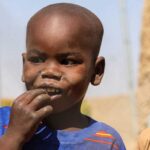Mrs Johnson’s (not real name) daughter was recently diagnosed with pneumonia. She recalls the child suffered fever and difficulty in breathing before she took her to hospital.
She spent one week at the hospital, where she was treated and discharged after taking several doses of injections.
- Presidential bid: Emefiele withdraws suit against INEC, AGF
- IPOB kills woman, 4 kids, 6 other northerners in Anambra
Prof. Wilson Osaretin Osarogiagbon, a Professor of Pediatric Immunology with the University of Benin Teaching Hospital described pneumonia as an infection of the lungs – the organs meant for breathing.
“When the lungs are affected by the presence of micro-organism, either bacteria, virus or fungi that lead to a situation when the lungs which are supposed to contain air sacs are filled with fluid which become solid instead of sponging, thereby making the lungs solid and breathing difficult,” he said.
He said pneumonia is one of the major causes of under-five children’s deaths globally.
He noted that some wrong beliefs about pneumonia include that the disease is caused by children not wearing clothes, bathing under rainwater, opening the chest during harmattan, sleeping under the fan as well as witches and wizards among others.
He said, however, that the ailment is not caused by cold or dreams of eating food while asleep, stressing that it is caused by infection from polluted environment among other things.
Risk factors
Prof. Osarogiagbon who is also a consultant immunologist, described the risk factors as environmental pollution, smoke and cigarette smoke inhalation, exposure to cooking within the house (especially firewood), lack of breastfeeding, children born prematurely, children not immunised against the six killer diseases and crowded environment (area without ventilation) among others.
He also stated that children who are not breastfed are at greater risk of having pneumonia.
Signs and symptoms
The expert identified symptoms of pneumonia as difficulty in breathing (having recession in the chest either below the ribs or in-between them), coughing and fever.
He said the moment a child’s eyes are turning blue, and he or she can’t eat, vomits, convulses and loses consciousness, the mother should know the disease is becoming serious and should take the child to the hospital.
Diagnosis
He said to diagnose pneumonia, one needs to take a look at the symptoms, as the child may have a fever, and not breathing well among others.
“When a doctor examines the baby’s chest with a stethoscope, he will observe something like difficulty in breathing while the respiratory rate will go up. He or she would also observe abnormal sound in the chest through the stethoscope called crepitation.
“So, as a doctor, once the respiratory rate is more than normal and the baby is having fever, then you know it is pneumonia. It can also be diagnosed through x-ray.”
Prevention
Prof. Osarogiagbon said to prevent pneumonia in children, people should ensure hygienic environment, (whether industrial or home), good ventilation, breastfeeding and immunisation (routine or specific.
He advised that when a child shows symptoms of pneumonia, he/she should be taken to hospital, as early presentation is key to treating the disease.
He, however, lamented that most children with pneumonia are always presented late to hospital for treatment.
Pneumonia caused by bacteria can be treated with antibiotics
According to the World Health Organisation (WHO), pneumonia should be treated with antibiotics.
“The antibiotic of choice for first-line treatment is amoxicillin dispersible tablets.
“Most cases of pneumonia require oral antibiotics, which are often prescribed at a health centre. These cases can also be diagnosed and treated with inexpensive oral antibiotics at the community level by trained community health workers.
“Hospitalisation is recommended only for severe cases of pneumonia,” it said.

 Join Daily Trust WhatsApp Community For Quick Access To News and Happenings Around You.
Join Daily Trust WhatsApp Community For Quick Access To News and Happenings Around You.


